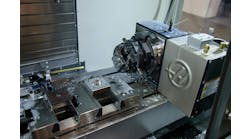Accelerate Lean Six-Sigma in Job Shops
Most job shops are defined by selling and producing in a make-to-order environment. Production orders are executed only in response to a specific customer order for a discrete quantity and due date. As such job shop managers typically do not regard inventory management as a key component to their customer service levels and operating profit. Rather, the LEAN Six-Sigma approach to improving factory responsiveness is favored over inventory management initiatives. This paper presents the perspective that the LEAN Six-Sigma tools that reduce set-up and improve process yields must be combined with the strategic use of inventory to decrease production costs and to create profit generating market offers.
The Job Shop Reality
Let's face reality. Most of the high run "easy" jobs have been outsourced to off-shore production facilities. Companies in North America are surviving, and thriving, because they offer a product and a service. Buyers who purchase manufactured components cannot always rely on the long lead times and variable quality offered by remote off shore manufacturers. This is especially true for defense, aerospace, and medical companies that require short-run "difficult to make" component parts
One manufacturing executive recently described his North American manufacturing company in the following manner. "We are a job shop. You know, custom orders. The customer places an order for the exact amount and we have to deliver that exact quantity. The customer rarely cares that our production yield is variable from one production run to the next. And now, more than ever, we must pursue internal improvement quickly. We have to eliminate waste, get better at set-ups, improve efficiency, get better forecasts, and better predict our production operations."
The above description is typical for many production managers who believe that their operations are a job shop because current markets demand lower volume and higher product mix. Shorter production runs and a more difficult product mix are often coupled with customers who have just-in-time initiatives focused on minimizing inventory. In response to the need to operate with a just-in-time inventory strategy, it seems that customers constantly change their mind about what they need and when they need it. This unsettling situation exists even with sophisticated customers who possess the power of modern technology in the form of Enterprise Resource Planning, Material Requirements Planning, and Master Production Scheduling.
MRP Variability in Job Shop Supply Chains
On a periodic basis (usually weekly), demand orders are placed into a planning module of Enterprise Resource Planning (ERP) called the Master Production Schedule (MPS.) The MPS is a combination of forecast and firm customer orders. Data from the MPS is analyzed by the MRP module which calculates component part needs by allocating available inventory and, then, recommending purchase orders and production work orders. The difficulty in using MPS/MRP is that these systems are too precise and are revised too frequently. For example, any inventory accuracy errors are passed on to the MRP module. Data errors cascade through MRP and create inaccurate demand. Other inventory accuracy errors arise due to timing differences with inventory transactions or quality holds. When material transactions are not real-time MRP cannot "see" the material and does not allocate its availability to demand. Further, the materials planning process begins with the MPS that contains a number of orders that represent a "best guess" of future demand. All too often, these forecasts will change with changes in sales projections or budget revisions within the top level business plan. If projected revenue is changed and that data is loaded into MPS/MRP, then the material system will drive an entirely new set of material requirements regardless of current order commitments or consideration of internal or external constraints.
Batch Sizing Dilemma
Competitive North American manufacturers add value by helping their customers recover from the changes in order patterns caused from using MPS/MRP. Suppliers absorb the demand variability by shrinking quoted lead times, rescheduling production orders, and finding unplanned capacity. However, these techniques used to absorb the order variability can be expensive. The use of overtime, expedited outside services, and disruption to work flow decreases productivity and increases production costs.
A significant factor that contributes to the demand variability is batch sizing based on volume purchase discounts. Most industries still use standard costing methods that result in lower prices as batch sizes increase. Set-up time and overhead are spread over more units resulting in a lower unit cost. If a supplier uses standard cost for pricing, then a price break is given for larger quantities. Thus, a dilemma is created for the customer's material planners and buyers when analyzing MRP generated material purchases. The planners and buyers wrestle with the conflict between price and their just-in-time inventory strategy. In order to get a lower price, the buyer must often buy more than what is needed in the near term. This batch size dilemma becomes amplified when a planner/buyer needs to expedite supply orders. When expediting is requested by a customer a supplier may use overtime, extra freight, and premium payments to decrease production cycle times for outside services such as heat treat, plating, or polishing. Larger batch sizes consume more cycle time and, thus, increase the cost to react to order changes recommended by MRP.
Competitive suppliers will typically address the batch size dilemma by using LEAN Six-Sigma tools to reduce set-up times and to improve process yields. Set up reduction alleviates, to some degree, the batch size dilemma. Faster set-up times results in smaller production batches which, in turn, creates lower standard costs and makes production more flexible. Improved process yields have a direct impact on raw material and, therefore, standard costs. A lower standard cost allows the supplier to offer smaller order sizes at a given price point. As a result of set-up reduction and improved yields a more flexible production operation can offer smaller batches and react to order variability with less spending. However, there are limitations to set-up reduction and yield improvement programs. One limitation is that, in order to lower production work order batch size, every set-up in a routing may need to be improved. Usually additional set-ups often result in lower yield by using "test pieces" to ensure quality. Another limitation is that set-up time is often determined by an equipment configuration or a treatment process that requires a specific batch size range to ensure quality. A further limitation is that set-up reduction programs at upstream processes may be outsourced and not within the control of the supplier attempting to reduce batch size.
How to Solve the Batch Size Dilemma
While employing the LEAN Six-Sigma set-up reduction and yield improvement, there is an additional approach needed to effectively deal with disruption from MRP and the batch size dilemma. An effective approach to running a low cost and highly responsive custom-repeat production operation requires the creation of shock absorbers in the supply chain. The shock absorbers must dampen the negative effects caused by MRP and the batch size dilemma. A proven methodology for creating the shock absorbers is a "push-pull" inventory management system called actively synchronized replenishment (ASR).
In most ASR models, there are two inventory buffers. A customer buffer is replenished from a production warehouse buffer. The small buffer of inventory held at the customer is large enough to cover the demand during the time that it takes to be replenished. In most cases the time to replenish will be, essentially, transportation time. When the customer buffer is consumed to a predetermined level, a replacement order is awarded to the supplier, regardless of the recommendations from MRP.
As the customer buffer is replenished based on actual consumption, it represents the point for "pull". In contrast, the production warehouse buffer represents the point of "push" and is held in the production warehouse at the supplier. When the production warehouse buffer is consumed below a predetermined level, an order is placed with the supplier's planning department for replenishment. ASR adds a powerful component to the "pull" side of the "push-pull" method by recalculating buffer sizes based on recent historical usage. The recalculation of buffer sizes keeps inventory adjusted, up or down, to a rolling average of actual consumption. Thus, inventory is optimized to provide an appropriately sized shock absorber that minimizes inventory exposure in the supply chain while simultaneously providing inventory availability. This "push-pull" method allows the manufacturer to manage in-house buffer levels with predetermined production batch sizes. As the MRP purchase signal is replaced with a "pull" signal for smaller batches and the supplier can produce batch sizes that match process capabilities, ASR overcomes both the disruption from MRP and the batch size dilemma.
Market Offers
Actively synchronized replenishment works well for any number of job shops and any number of parts or assemblies. Its implementation can be complicated, however, by pricing policies, products with deep Bills of Materials, transportation costs, intermittent or seasonal demand patterns, and supply chain policies. For example a planner/buyer may be evaluated on purchase price variance rather than total cost approach that includes inventory investment costs. Additional conflict will arise when ASR recalculates buffer sizes and recommends a change in economic production batch sizes. Further, there are challenges to achieving cooperation between internal sales personnel who must change pricing strategy and the customer who must order based on pull. Although implementation may take some patience, ASR has proven to work equally well with finished goods, subassemblies, and raw materials. It has been implemented with various approaches to technology that includes Sigmabin card systems, modified MRP approaches, and "bolt on" replenishment software packages.
The internal benefits of ASR are significant as the manufacturer can control and vary batch size while level loading near term production schedules with replenishment orders. Expedites are reduced and, in many cases, eliminated. Freight costs and premiums for expediting outside services are better controlled as well. The customer benefits from reduced inventory and less order maintenance. A "one price -- any quantity" policy eliminates the need to review pricing for every MRP purchase order recommendation. In most cases, a mature replenishment implementation will position a supplier to offer a guarantee that the customer will never be out of stock. However, you must be careful in making a market offer without a thorough analysis. Relationships and policies within a supply chain can be complex. Market offers based on ASR should only be made after conducting a thorough analysis of the offer and identifying the offer's potential side effects for both buyer and supplier. A solid implementation plan will be necessary to deliver on the promises made from implementing ASR.
Whether you are managing a make-to-order or a make-to-stock operation, the first step in evaluating the potential for ASR is to challenge your assumptions about why customers order they way they do. By converting as little as 20%-30% of your custom, repeat business from make-to-order to ASR will yield dramatic service level improvements at lower production costs. One implementation resulted in improving inventory turns from 6 to 16 while decreasing customer lead times from 4 weeks to 3 days. In a separate case, a manufacturer reported increasing inventory turns from 2 to 15, maintaining on time to 100%, and doubling gross profit. These improvements can be made regardless of the improvements you make in set-up reduction and process yield. Furthermore, ASR provides an avenue for differentiating your company in the market. Properly implemented ASR removes the inventory and batch size dilemma from the customer and replaces it with a win-win solution. A well polished replenishment market offer has proven to be difficult to match. It has also awarded suppliers with moderate price premiums and has been an effective defense against competition for existing business.
Michael Pitcher is the founder of Operations Excellence Consulting, Inc. a company that specializes in high-performance process improvements. He is a Productivity Consultant and leading expert in leveraging the combination of LEAN, Six-Sigma,and the Theory of Constraints. www.excellence1.com



